EUROPEAN SPACE AGENCY
1. Context
The ESA hopes to send the first of its new class of budding astronauts to the International Space Station by 2026
By 2030, the ESA hopes all 17 members of its new “Class of 2022” will have the chance either to fly to the International Space Station, or into space

2.About European Space Agency (ESA)
- The European Space Agency (ESA) is an intergovernmental organization established in 1975 with the goal of coordinating and promoting European cooperation in space research and technology. Its headquarters is located in Paris, France, and it currently has 22 member states.
- The European Space Agency (ESA) is Europe’s gateway to space. Its mission is to shape the development of Europe’s space capability and ensure that investment in space continues to deliver benefits to the citizens of Europe and the world
- ESA is an international organisation with 22 Member States. By coordinating the financial and intellectual resources of its members, it can undertake programmes and activities far beyond the scope of any single European country.
- ESA's programmes are designed to find out more about Earth, its immediate space environment, our Solar System and the Universe, as well as to develop satellite-based technologies and services, and to promote European industries. ESA also works closely with space organisations outside Europe.
3. Missions of ESA
- ESA's mission is to explore space, develop space technology, and promote European industries. It conducts space research, develops and launches satellites and other spacecraft, and collaborates with other space agencies around the world, including NASA and Roscosmos
- Some of ESA's notable achievements include the launch of the Huygens probe to Titan, the largest moon of Saturn, as part of the Cassini-Huygens mission, the development and operation of the Galileo navigation system, and the ongoing operation of the International Space Station (ISS) in collaboration with other space agencies
- ESA's current priorities include Earth observation, climate change research, exploration of the Solar System, and the development of advanced space technology.
- It also runs a range of educational and outreach programs to engage the public in space science and inspire the next generation of space explorers.
4. Members of ESA
Austria, Belgium, Czech Republic, Denmark, Estonia, Finland, France, Germany, Greece, Hungary, Ireland, Italy, Luxembourg, the Netherlands, Norway, Poland, Portugal, Romania, Spain, Sweden, Switzerland and the United Kingdom. Slovakia, Slovenia, Latvia and Lithuania are Associate Members. Canada takes part in some projects under a cooperation agreement.
Bulgaria, Croatia, Cyprus and Malta have cooperation agreements with ESA
Source: esa.int




